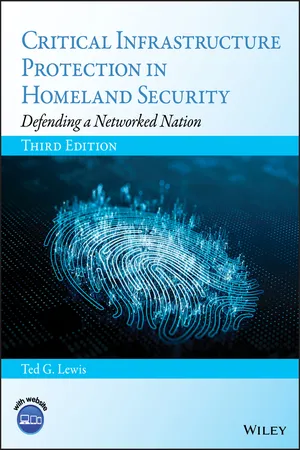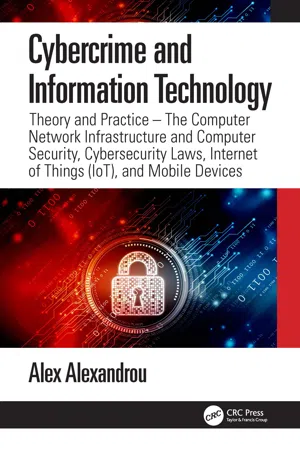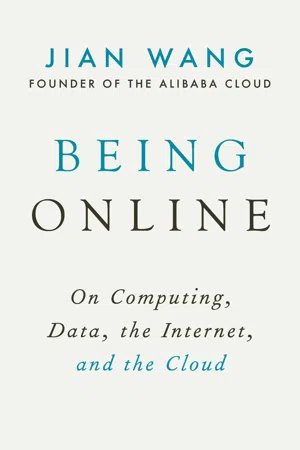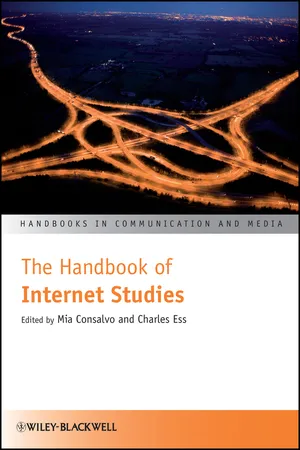Internet Concepts
Internet concepts encompass a range of fundamental ideas related to the functioning and use of the internet. These include concepts such as IP addresses, domain names, protocols (such as HTTP, FTP, and TCP/IP), web servers, and web browsers. Understanding these concepts is crucial for navigating and utilizing the internet effectively, as well as for developing and maintaining web-based applications and services.
4 Key excerpts on "Internet Concepts"
- eBook - ePub
Critical Infrastructure Protection in Homeland Security
Defending a Networked Nation
- Ted G. Lewis(Author)
- 2019(Publication Date)
- Wiley(Publisher)
...6 INTERNET The Internet uses the communications sector to link computers, cellular telephones, tablets, transportation systems, water and power systems, and industrial control systems together. It extends the communications sector to applications such as the World Wide Web (WWW), email, video streaming, and smartphone apps like face‐to‐face conferencing and photograph‐sharing services. A more precise technical definition says the Internet is a global network that uses Transmission Control Protocol/Internet Protocol (TCP/IP). Any device that connects to other devices via TCP/IP becomes part of the Internet by definition. While the Internet has been around for over 50 years, it began to spread like an epidemic after TCP/IP was created and adopted by the US Department of Advanced Research Projects Agency (ARPA) (and later Defense Advanced Research Projects Agency [DARPA]), and the US government declared it open and available for commercialization in 1998. TCP/IP is the lingua franca of global communications and the basic “building block of the Internet's DNA.” Open access and free open source software (FOSS) accelerated the explosive adoption of the Internet within a few decades beyond 1998. The Internet started as an idea on paper and grew into one of the largest man‐made machines in the world. Experts fully expect that all 7.5 billion inhabitants of the globe will eventually be on the Internet—perhaps by the mid‐2020s. But the spread of TCP/IP goes beyond the population of the planet. Billions more machines communicate via the Internet from automobiles, factories, power grids, gas and oil pipelines, water systems, and everyday products. This proliferation of connected devices at the edge of the Internet has become known as the Internet of Things (IoT)...
- eBook - ePub
Cybercrime and Information Technology
Theory and Practice: The Computer Network Infostructure and Computer Security, Cybersecurity Laws, Internet of Things (IoT), and Mobile Devices
- Alex Alexandrou(Author)
- 2021(Publication Date)
- CRC Press(Publisher)
...In this chapter you will learn to understand each of these steps and appreciate the network devices and processes that make them possible. The term “computer network” refers to two or more interconnected computing devices or machines that can communicate with each other. The fundamental goal of computer networking is simple—to securely share information and resources. It is the execution that is not simple at all. 5.1 Introduction to Computer Networking Over the centuries, some human inventions have provided transformative changes in our lives. Inventions such as the wheel, compass, concrete, steel, gunpowder, and nails have extended the boundaries of civilization and human knowledge and have moved innovation forward. The end of the 18th century brought the age of the steam engine, 1 powered by coal. In the late 19th century, commerce changed again due to the discovery of oil and innovations in manufacturing, such as Henry Ford’s assembly line and the work of Frederick Winslow Taylor, the father of scientific management. 2 1 Deane, Phyllis M., and Phyllis M. Deane. The first industrial revolution. Cambridge University Press, 1979. 2 Kanigel, Robert. “The one best way: Frederick Winslow Taylor and the enigma of efficiency.” MIT Press Books 1 (2005). The 20th century brought us automation, information gathering and processing, the Internet, and mobile phones. 3 In the 21st century the word “connected” now describes the significant advancements in technology that has changed our world once again. 3 Morrar, Rabeh, Husam Arman, and Saeed Mousa. “The fourth industrial revolution (Industry 4.0): A social innovation perspective.” Technology Innovation Management Review 7, no. 11 (2017): 12–20. The Internet is an enormous global network of networks that can connect every computing device to its vast resources and to every other computer on the planet...
- eBook - ePub
Being Online
On Computing, Data, the Internet, and the Cloud
- Jian Wang(Author)
- 2021(Publication Date)
- Arcade(Publisher)
...Chapter 8 The Fusion of the Internet, Data, and Computing Data has no inherent value, just as the footprints you leave on the ground have no value unless they are processed by computing power. Computing is like infrastructure: it can turn the accumulated grains of sand that are data into economic and industrial wealth. The internet becomes infrastructure; data becomes the means of production; and computing becomes a public utility. Let computing be a power possessed by every human being and data an asset shared by the world. The Internet Becomes Infrastructure and a Platform for Innovation The internet has become the infrastructure for every country’s economic and societal development, and it greatly expands the constraints of space and time in our daily lives. In what way is it a type of infrastructure? Simply put, it’s just like highways and railways. However, the internet as infrastructure isn’t bounded by the limitations of space and time as we know them, thereby surpassing roads and railways. Without infrastructure, a country has no GDP. What is the internet? Today, people have vastly differing answers to this question. In the past, everyone was focused on the internet by itself, and now their attention has shifted to the mobile internet and industry internet, as people would like to call them. At the Global Mobile Internet Conference in 2011, when I was still very confused about its nature, I said that the mobile internet wasn’t the same thing as the internet. Later, I discovered I’d been wrong. The mobile internet is still the internet. The mobile internet and the industrial internet, including what people refer to as the internet of things, are all part of the internet—their foundation is the internet. Today’s internet is very different from that of ten or twenty years ago, inasmuch as it has become the infrastructure for economic growth and societal progress...
- eBook - ePub
- Mia Consalvo, Charles Ess, Mia Consalvo, Charles Ess(Authors)
- 2011(Publication Date)
- Wiley-Blackwell(Publisher)
...Introduction: What is “Internet Studies”? Charles Ess and Mia Consalvo The project of saying what something is may helpfully begin by saying what it is not. In our case, “Internet studies” as used here is not primarily a study of the technologies constituting the ever-growing, ever-changing networks of computers (including mobile devices such as Internet-enabled mobile phones, netbooks, and other devices) linked together by a single TCP/IP protocol. Certainly, Internet studies in this sense is relevant – in part historically, as these technologies required two decades of development before they became so widely diffused as to justify and compel serious academic attention. That is, we can trace the origins of the Internet to the first efforts in 1973 by Vincent Cerf and Robert E. Kahn to develop the internetworking protocol that later evolved into TCP/IP (cf. Abbate, 2000, pp. 127–33). By contrast, we and our colleagues seek to study the distinctive sorts of human communication and interaction facilitated by the Internet. These begin to emerge on a large scale only in the late 1980s and early 1990s as within the US, ARPANET and its successor, NSFNET (an academic, research-oriented network sponsored by the United States National Science Foundation) opened up to proprietary networks such as CompuServe and others (Abbate, 2000, pp. 191–209). NSFNET simultaneously fostered connections with networks outside the US built up in the 1970s and 1980s: 250 such networks were connected to NSFNET by January 1990, “more than 20 percent of the total number of networks” – and then doubled (to more than 40 percent) by 1995 (Abbate, 2000, p. 210)...



